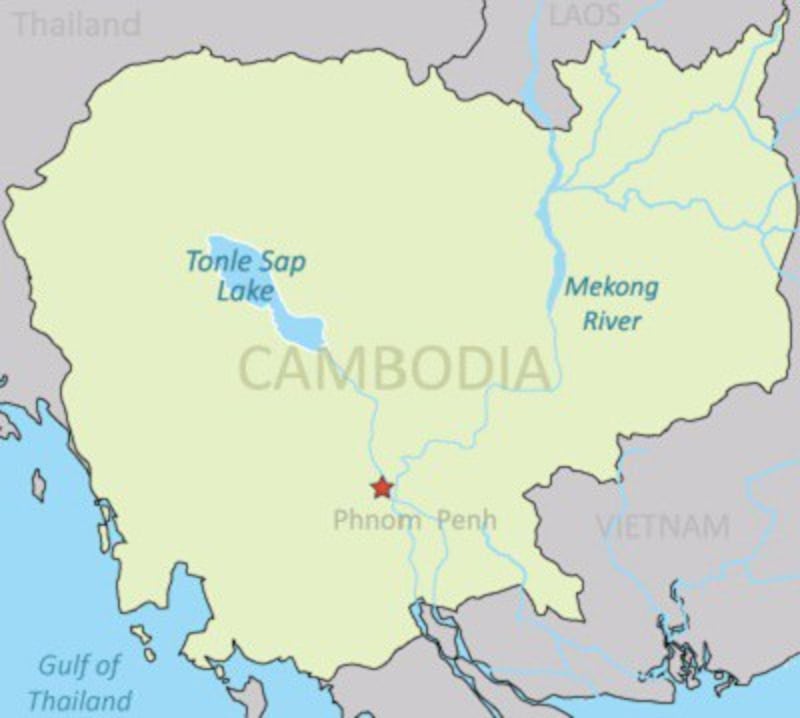As water levels in the lower-Mekong region hit record lows for the second year in a row, a report published Friday by the intergovernmental Mekong River Commission urged China, Myanmar and its member countries to share more data about hydroelectric dam operations to enable all parties to prepare for droughts and floods.
The report by the MRC – made up of Cambodia, Laos, Thailand and Vietnam -- examined river conditions in the lower Mekong between January and July 2020, attempting to identify causes for the lowest reverse flow intake since 1997 in Tonle Sap, Southeast Asia’s largest lake.
A series of 13 dams on the Mekong river—11 in China and two in Laos—as well as many more dams in the river’s tributaries in Laos, alter the Mekong’s natural flow significantly, but mitigating the effects of the reduced flow depends on governments having the best possible information, the report said.
“We call on the six Mekong countries to increase data and information sharing on their dam and water infrastructure operations in a transparent and speedy manner with the MRC,” said Dr. An Pich Hatda, the MRC Secretariat’s Chief Executive Officer in a media release.
“It is time to walk the talk and to act in the common interest of the entire Mekong River Basin and the affected communities,” he said.
To increase transparency, the MRC asked China to provide more data from its dam operations in the upper Mekong basin, including dry season information, and called on the MRC members to share data for tributary dams. Armed with more accurate information, the member countries would be able to plan for disasters, the MRC advised.
“Cooperation with the upstream countries China and Myanmar is crucial for a comprehensive assessment of rainfall in the Upper Mekong Basin (UMB) or Lancang River Basin, including information about releases from their storage,” it said.
“Information and data sharing between all the six riparian countries is vital for the MRC to ascertain the causes of the low flows and for countries to implement the suggested mitigation options that they consider viable,” the report said.
Laos operates two dams on the mainstream Mekong and is in various stages of planning or building nine more, under the country’s ambitious but controversial strategy to position itself as the “Battery of Southeast Asia.”
‘Effective water diplomacy‘
The report recommended that member countries go forward with drought management plans, and ask dams storing water to release some, and irrigators to use less, if severely low water levels continue for the rest of the flood season.
The MRC said it would work toward a more permanent mode of cooperation in drought and flood mitigation plans, but it said solutions “depend on effective water diplomacy.”
“Transparent data and information sharing is fundamental both in the short and long run. The lack of information on the operations of water infrastructures in the Mekong River Basin has presented a significant challenge to comprehensive assessment and accurate forecasting,” the report said.

Every year at the arrival of the rainy season around June, the Tonle Sap lake in Cambodia expands as high volumes of rainwater cause the Tonle Sap river that normally drains the lake to flow backward. By the end of the monsoon season in October, the lake typically increases four times in size before it starts draining again.
The inland lake is one of the world’s biodiversity hotspots and is Southeast Asia’s most bountiful source of freshwater fish. The greater Mekong river system provides fish, water and fertilizer for 60 million Southeast Asians.
In 2019, the river went into fill mode much later than normal as a severe drought gripped the lower Mekong. The drought has continued well into 2020, and apart from two instances of reverse flow in July the MRC described as “extremely small,” the lake only started taking on water in normal volumes this week after a tropical storm hit some parts of the region.
The severely low water level of the lake could spell disaster not only for Cambodia but every MRC member state.
“The low flows could have severe impacts on Cambodia due to a loss of fisheries and irrigation potential. Vietnam may experience reduced productivity in the Delta rice bowl. Agricultural productivity in Lao PDR and Thailand are also likely to be affected,” the MRC said in the report.
Upper Mekong dams
The MRC said that more rainfall than usual is expected in August and September, and water levels across the entire lower Mekong basin are increasing and will likely to continue to rise through next week.
Though the MRC could not definitively verify the level of impact of Mekong river dams on the region’s low water levels, independent studies have pointed to the dams as a culprit.
In April, Eyes on Earth, Inc. and Global Environmental Satellite Applications, Inc. issued a joint report based on satellite data from 1992 to 2019 and daily river height gauge data from Thailand which found that 126.44 meters (415 feet) of river height was missing at the gauge over the 28-year record.
The report noted that a Chinese state-owned enterprise had built a series of dams on the Mekong during that time.
According to the study, the severe lack of water in the Lower Mekong during the wet season of 2019 “was largely influenced by the restriction of water flowing from the upper Mekong.”
“Cooperation between China and the Lower Mekong countries to simulate the natural flow cycle of the Mekong could have improved the low flow conditions experienced downstream between May and September of 2019,” the joint report said.
